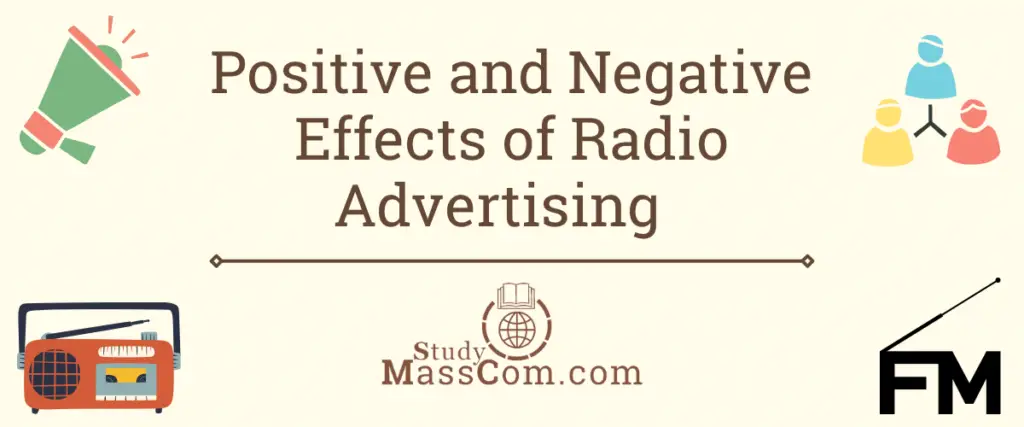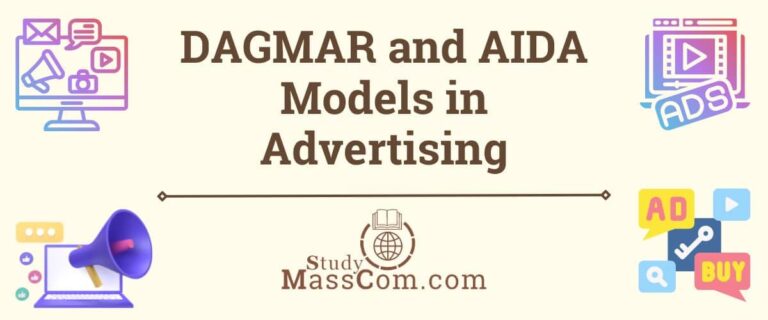Positive and Negative Effects of Radio Advertising
Introduction
In the fast-paced digital age, where marketing strategies continue to evolve, radio advertising has withstood the test of time. The medium has played a significant role in the advertising industry, captivating audiences for decades. In this blog post, we will delve into the positive and negative effects of radio advertising, shedding light on its enduring impact in a modern landscape dominated by online platforms.

What is Radio Advertising?
Radio advertising refers to the practice of promoting products, services, or brands through audio messages broadcasted on radio stations. It involves creating persuasive and engaging commercials or advertisements that are aired during specific time slots or programs to reach a target audience. Radio advertising relies on the power of sound and storytelling to capture listeners’ attention, evoke emotions, and convey key marketing messages. It allows advertisers to leverage the broad reach of radio to connect with a diverse audience, while also offering options for local targeting. Radio advertising plays a significant role in marketing strategies, offering a cost-effective medium to raise brand awareness, drive consumer engagement, and influence purchasing decisions.
Why is Radio Advertising Booming Now?
Radio advertising continues to boom for several reasons:
1. Wide Reach
Despite the proliferation of digital media, radio remains a highly accessible and prevalent medium. It reaches a vast audience, including people in both urban and rural areas, across various demographics and age groups. This wide reach ensures advertisers can connect with a diverse consumer base and maximize their brand exposure.
2. Engaging and Personalized Content
Radio offers a unique advantage in terms of creating engaging and personalized content. Through the power of storytelling, captivating audio commercials, and well-curated music programming, radio stations can captivate listeners and forge a personal connection. This personalization helps to build trust and loyalty among listeners, making radio advertising an effective means to communicate marketing messages.
3. Local Targeting
Radio stations often cater to specific regions or local communities, making it an ideal medium for local businesses. Advertisers can target their ads to specific geographic areas, allowing them to connect with consumers who are more likely to engage with their products or services. This localized targeting helps businesses establish a strong presence within their immediate market.
4. Cost-Effectiveness
Radio advertising offers a cost-effective marketing solution, especially for businesses with limited advertising budgets. Compared to other traditional mediums like television or print, radio advertising tends to be more affordable. Advertisers have the flexibility to choose from various ad formats, durations, and time slots, allowing them to optimize their spending and achieve a favorable return on investment.
5. Emotional Impact and Brand Recall
The power of sound and the art of audio storytelling can evoke strong emotions and leave a lasting impact on listeners. Through cleverly crafted jingles, catchy slogans, and memorable narratives, radio ads can create a unique brand identity and enhance brand recall. This emotional connection and recall contribute to brand loyalty and can influence consumer purchasing decisions.
6. Adaptability to Digital Trends
Radio has successfully adapted to digital trends, ensuring its relevance and attractiveness to advertisers. Many radio stations now offer online streaming options, podcasts, and digital platforms, expanding their reach beyond traditional airwaves. This integration with digital technology allows advertisers to explore cross-channel marketing strategies and reach audiences who consume radio content through digital platforms.
7. Complementing Multi-Channel Campaigns
Radio advertising works synergistically with other marketing channels. It complements digital, television, print, and outdoor advertising efforts, creating a comprehensive and integrated marketing campaign. By including radio in a multi-channel approach, advertisers can reinforce their brand message and maximize their impact by reaching audiences across various touchpoints.
In summary, radio advertising is booming due to its wide reach, engaging content, local targeting options, cost-effectiveness, emotional impact, adaptability to digital trends, and its ability to complement multi-channel marketing strategies. These factors contribute to its continued success and effectiveness in capturing the attention and influencing the purchasing decisions of consumers.
Positive and Negative Aspects of Radio Advertising: Key Points
Here’s a comparative chart highlighting the positive and negative effects of radio advertising:
| Positive Effects of Radio Advertising | Negative Effects of Radio Advertising |
| Broad reach, targeting diverse demographics | Limited visual impact, inability to showcase products visually |
| Engaging storytelling and imaginative experiences | Background noise and potential distraction |
| Cost-effective compared to other mediums | Limited targeting options compared to digital advertising |
| Opportunity for frequency and repetition | Difficulty in tracking ROI compared to digital platforms |
| Real-time updates and timely messaging | Fragmented audiences due to digital streaming options |
| Creates brand recall and emotional connection | Limited control over who hears the message |
Positive Effects of Radio Advertising
1. Broad Reach and Local Targeting
Radio has a broad reach, making it accessible to a wide range of listeners. It has the power to penetrate both urban and rural areas, targeting diverse demographics. Additionally, radio stations often cater to specific regions, allowing advertisers to reach a local audience effectively.
2. Engaging and Imaginative
Radio advertising has the unique ability to engage listeners through the power of storytelling. By leveraging the listener’s imagination, advertisers can create vivid mental images and evoke emotions. This auditory experience can leave a lasting impression on the audience, fostering brand recall and loyalty.
3. Cost-Effective
Compared to other advertising mediums like television or print, radio advertising is relatively cost-effective. It offers competitive pricing, making it a viable option for small and medium-sized businesses with limited budgets. Radio spots can be tailored to different durations, offering flexibility in investment and ensuring optimal return on investment (ROI).
4. Frequency and Repetition
Radio advertising enables advertisers to reinforce their message through frequency and repetition. By airing ads at specific times or during popular programs, they can ensure repeated exposure to the target audience. This repetition helps build brand recognition and increases the likelihood of consumer action.
5. Timely and Relevant
Radio advertising allows for real-time updates, making it ideal for time-sensitive promotions and announcements. Advertisers can respond swiftly to market trends and events, ensuring their message remains relevant and impactful. This dynamic nature of radio advertising helps maintain a competitive edge in a rapidly changing business environment.
Negative Effects of Radio Advertising
1. Limited Visual Impact
Unlike television or online platforms, radio lacks a visual element. Advertisers are unable to showcase their products or convey visual cues that aid in brand recognition. This limitation may hinder the effectiveness of certain types of products or services that heavily rely on visual appeal.
2. Background Noise and Attention Span
Radio often serves as a background medium, with listeners engaged in other activities simultaneously. The presence of ambient noise and distractions may diminish the listener’s attention and recall of the advertisement. Advertisers must work creatively to grab attention and deliver their message effectively within a limited timeframe.
3. Limited Targeting Options
While radio offers a broad reach, it can lack precise targeting options available in digital advertising. Advertisers have limited control over who hears their message, making it challenging to reach specific niche markets or demographics. This limitation may result in inefficient ad spending if the intended audience is not effectively reached.
4. Difficulty in Tracking ROI
Measuring the exact impact of radio advertising can be challenging compared to digital platforms. Tracking the success of radio campaigns and determining the return on investment can be complex due to the lack of direct response mechanisms. Advertisers must rely on indirect methods, such as audience surveys or promotional codes, to assess campaign effectiveness accurately.
5. Fragmented Audiences
With the rise of digital streaming platforms and personalized content consumption, radio audiences have become fragmented. People have numerous options to choose from, resulting in reduced overall listenership. This fragmentation may make it more difficult for advertisers to reach a substantial audience through radio alone.
Conclusion
In conclusion, radio advertising continues to hold its ground as a resilient and impactful marketing medium. Its positive effects, including broad reach, local targeting, engaging storytelling, cost-effectiveness, and the ability to deliver timely messages, make it a valuable tool for advertisers. However, it is important to acknowledge the negative effects, such as limited visual impact, background noise, limited targeting options, difficulty in tracking ROI, and fragmented audiences. Ultimately, radio advertising remains a powerful tool for building brand awareness, fostering emotional connections with consumers, and driving business results. Its enduring presence and ability to adapt to changing times make it an essential component of any well-rounded marketing campaign.
FAQs
Radio advertising can be an effective marketing tool when used strategically. It offers several advantages that make it a viable option for businesses looking to reach a wide audience and promote their products or services.
One of the key benefits of radio advertising is its wide reach. Radio has a broad audience, and people often tune in during their commutes, at work, or while doing household chores. This provides advertisers with an opportunity to engage with a diverse range of listeners and increase brand awareness.
Radio advertising also allows for precise geographic targeting. Local businesses can take advantage of this feature to reach their target audience effectively. By advertising on local radio stations, businesses can connect with the local community and promote their offerings to potential customers in the area.
Cost-effectiveness is another advantage of radio advertising. Compared to other forms of advertising, such as television or print, radio ads can be more affordable. This makes it an attractive option for businesses with limited marketing budgets, enabling them to promote their products or services without breaking the bank.
While radio advertising has its advantages, it’s important to conduct market research, analyze audience demographics, and monitor campaign performance to maximize its effectiveness. Factors such as target audience demographics, time slots, message creativity, and competition from other advertising channels can impact the success of radio advertising campaigns. By leveraging its strengths and optimizing its execution, businesses can effectively harness the power of radio advertising to achieve their marketing objectives.
1. Jingle or Song: Many memorable radio ads utilize catchy jingles or songs to create brand recognition and leave a lasting impression. Examples include the famous “I’m Lovin’ It” jingle used by McDonald’s or the “Nationwide is on your side” jingle used by Nationwide Insurance.
2. Voiceover Commercials: Voiceover commercials feature a narrator or spokesperson who delivers the ad message. These ads often use persuasive language, storytelling, humor, or emotional appeals to engage listeners. For instance, a car dealership might have a voiceover commercial highlighting their latest offers and emphasizing the benefits of their vehicles.
3. Sponsorships and Endorsements: Radio stations often have segments or programs sponsored by businesses. These sponsorships involve the advertiser’s name and message being mentioned during the program, such as “This program is brought to you by [Business Name].” Similarly, endorsements involve well-known personalities or influencers promoting a product or service on-air, lending their credibility to the advertisement.
4. Promotions and Contests: Radio stations frequently run promotions and contests in collaboration with advertisers. These ads encourage listeners to participate by offering prizes, discounts, or special offers. For example, a clothing store might advertise a radio contest where listeners have a chance to win a shopping spree or exclusive discounts.
5. Public Service Announcements (PSAs): PSAs are non-commercial ads aimed at promoting social causes, public health, or community initiatives. Radio stations often air PSAs as a way to give back to the community and raise awareness about important issues.
6. Direct Response Advertising: Direct response ads prompt listeners to take immediate action, typically by calling a toll-free number or visiting a website. These ads often offer exclusive deals, limited-time offers, or free trials. For example, a fitness club might run a radio ad encouraging listeners to call for a free trial membership.
These are just a few examples of radio advertising formats. The specific approach and style of radio ads can vary greatly depending on the advertiser’s goals, target audience, and creative strategy. The key is to create compelling and engaging content that resonates with the listeners and effectively communicates the desired message.
Radio advertising can have several effects on businesses and consumers. Here are some key effects of radio advertising:
1. Brand Awareness: Radio advertising helps create brand awareness by reaching a wide audience. Regularly hearing an ad on the radio can make the brand more familiar and recognizable to listeners. It increases the chances that consumers will remember the brand when they need a relevant product or service.
2. Increased Sales: Effective radio advertising can lead to increased sales for businesses. By promoting their products or services on the radio, businesses can attract new customers, encourage repeat purchases from existing customers, and drive traffic to their physical stores or websites. Well-crafted ads that effectively communicate the value proposition can generate immediate sales.
3. Audience Engagement: Radio ads have the potential to engage and captivate listeners. The use of persuasive language, storytelling, humor, or emotional appeals can capture the attention of the audience and leave a lasting impact. Engaged listeners are more likely to remember the ad, consider the advertised product or service, and take action.
4. Stronger Customer Relationships: Radio advertising can help businesses build stronger relationships with their customers. By consistently delivering messages that resonate with the target audience, radio ads can foster a sense of connection, trust, and loyalty. This can lead to long-term customer relationships and repeat business.
5. Influencing Consumer Behavior: Radio ads have the power to influence consumer behavior and purchasing decisions. Ads that highlight unique selling points, promotions, or exclusive offers can motivate listeners to try a new product, switch brands, or make a purchase. Effective radio advertising can shape consumer perceptions and preferences.
6. Drive Online Traffic: Radio advertising can drive online traffic by encouraging listeners to visit a specific website or engage with the brand on social media platforms. By providing a clear call-to-action and mentioning a website or social media handle, businesses can generate online interactions, inquiries, and conversions.
7. Complementing Other Channels: Radio advertising can complement other marketing channels and reinforce the overall marketing strategy. By combining radio ads with digital marketing, social media campaigns, or other forms of advertising, businesses can create a cohesive brand presence and reach customers through multiple touchpoints, maximizing the impact of their marketing efforts.
It’s important to note that the specific effects of radio advertising can vary based on factors such as target audience demographics, ad creative and messaging, market competition, and overall marketing strategy. Regular monitoring and analysis of campaign performance can help businesses assess the effectiveness of radio advertising and make adjustments to optimize their results.


